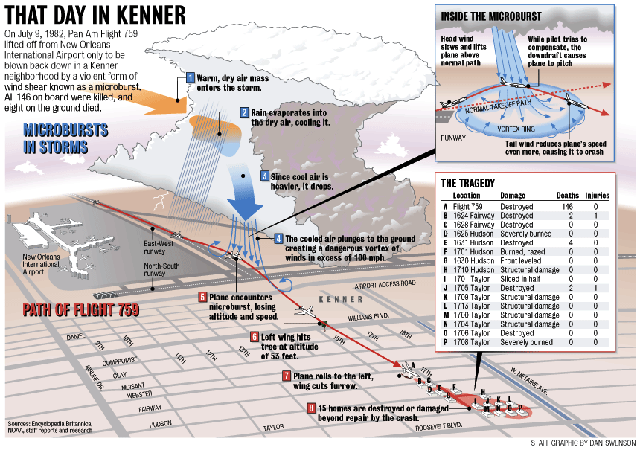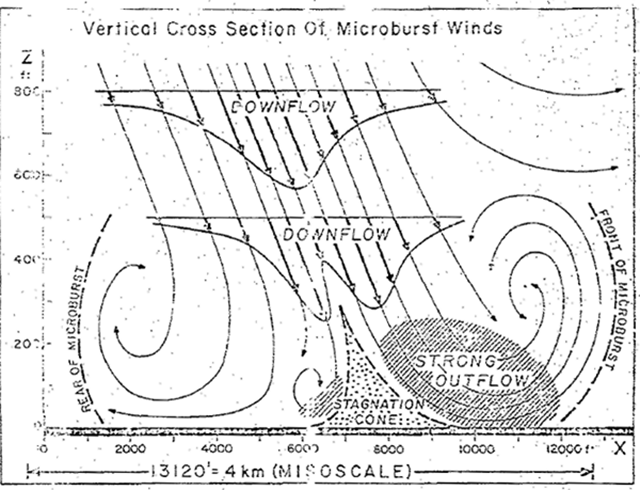Seven years after Eastern Air Lines 66, Low Level Windshear detection systems were in their infancy but were installed in New Orleans at the time of this mishap. The crew of Pan Am 759 had been warned. The winds had gone from calm, to 8 knots in a minute, to 17 knots gusting to 23 only four minutes later. The crew was given a windshear alert.
— James Albright

Updated:
2015-05-18
Their solution was to keep the airplane on the ground longer to build up speed and to takeoff with the air conditioning packs off to increase thrust. This may seem reckless but consider this: several aircraft had just taken off with full knowledge that there were thunderstorms in the area, including one on top of the airport. The NTSB concluded the captain's decision to take off was reasonable in light of the information available. We pilots, and our industry, simply didn't respect the fact that a microburst could far exceed the capabilities of our aircraft. Our knowledge has improved and this mishap would be avoided today by simply electing not to take off.

1
Accident report
- Date: 09 JUL 1982
- Time: 16:09
- Type: Boeing 727-235
- Operator: Pan American World Airways
- Registration: N4737
- Fatalities: 7 of 7 crew, 138 of 138 passengers
- Aircraft Fate: Destroyed
- Phase: Initial Climb
- Airport: (Departure) New Orleans International Airport, LA (MSY) (MSY/KMSY), United States of America
- Airport: (Destination) Las Vegas-McCarran International Airport, NV (LAS) (LAS/KLAS), United States of America
2
Narrative
- At 15:58:48 . . . the flight crew had received ATIS message Foxtrot which read in part "....time one eight five five Zulu, weather, two thousand five hundred scattered, two five thousand thin broken, visibility six miles in haze, temperature niner zero, wind two four zero at two, winds are calm altimeter three zero zero one..."
- The flight crew requested runway 10 for the takeoff and ground control cleared Clipper 759 to taxi to runway 10. At 15:59:03, the first officer requested a wind check and ground control informed the flight crew that the winds were 040° at 8 knots.
- At 16:02:34, while Clipper 759 was taxiing to runway 10, ground control, advised another airplane of low level wind shear alerts in the northeast quadrants of the airport.
- At 16:03:33, Clipper 759's first officer requested another wind check. Ground control replied, Wind now zero seven zero degrees at one seven... peak gusts two three, and we have low level wind shear alerts all quadrants, appears to be a frontal passing overhead right now, we're right in the middle of everything." The captain then advised the first officer to "...let your airspeed build up on takeoff..." and said that they would turn off the air conditioning packs for the takeoff, which would enable them to increase the EPR's on engines Nos. 1 and 3 to 1.92.
- At 1607:08, while the flight crew was completing the final items on the takeoff checklist, the local controller cleared Eastern Flight 956 to land on runway 10 and advised "...wind zero seven zero [at] one seven ... heavy Boeing just landed said a ten knot wind shear at about a hundred feet on the final." The CVR showed that this advisory was also received on Clipper 759's radio.
- According to witnesses, Clipper 759 lifted off about 7,000 feet down runway 10, climbed in a wings-level attitude, reached an altitude of about 100 feet to 150 feet above the ground and then began to descend.
- Clipper 759 crashed into a residential area and was destroyed during the impact, explosion, and subsequent ground fire. One hundred forty-five persons on board the airplane and 8 persons on the ground were killed.
Source: NTSB AAR 83-02, ¶1.1
3
Analysis
- According to the NWS, there were no SIGMET's. convective SIGMET's, Severe Weather Warnings, Local Aviation Warnings, or Severe Weather Watches in effect for the time and area of the accident.
- According to [a local] weather radar specialist, none of the weather radar echoes in the vicinity of New Orleans International Airport he observed either before or after the accident met the NWS Southern Region's special radar observation or severe weather criteria.
- Delta Airlines Flight 1622 departed from runway 10 at 155. According to the flight crew, the Bendix RDR-1-E radar was in normal mode and set on the 30-nmi range. The flight crew stated that there was a cell directly over the airport which extended slightly north of runway 10 and that there were other storm cells at their 1230 position at a range of 25 nmi.
- At 1601, Republic Airlines Flight 632, a DC-9-30, departed from runway 19. . . According to the captain, thunderstorms were all around the airport. . . . The Republic captain testified that during their takeoff roll they encountered heavy raid and wind shear about half way down runway 19 and the visibility became very poor.
- The Low Level Wind Shear Alert System (LLWSAS) was installed at the airport on August 30, 1979.
- The LLWSAS has several limitations: winds above the sensors are not detected; wind shears beyond the peripheral sensors are not detected; updrafts and downdrafts are not detected; and if a shear boundary happens to pass a particular peripheral sensor and center field sensor simultaneously, an alarm will not occur. In addition, the dimensions of some meteorological phenomena — down bursts or microbursts — may be smaller than the spacing between the sensors and thus not be detected.
Source: NTSB AAR 83-02, ¶1.7
- At rotation and liftoff, Clipper 759 was operating in a headwind; between liftoff and initial impact with the trees, the wind changed to a tailwind. The minimum and possible maximum magnitudes of this decreasing headwind shear were on the order of 19 knots and 40 knots, respectively. . . . In addition, between liftoff and initial impact, the airplane would have experienced a downdraft of between 10 fps to 5 fps.
- The Safety board concludes . . . Clipper 759 most probably experienced about a 38-knot decreasing headwind shear and about a 7 fps downdraft at 100 feet AGL.
Source: NTSB AAR 83-02, ¶2.2
The captain's decision to take off was reasonable in light of the information that was available to him.
Source: NTSB AAR 83-02, ¶3.1, item 21
4
Cause
The National Transportation Safety Board determines that the probable cause of the accident was the airplane's encounter during the lift-off and initial climb phase of flight with a micro-burst induced windshear which imposed a downdraft and a decreasing headwind, the effects of which the pilot would have had difficulty recognizing and reacting to in time for the airplane's descent to be arrested before its impact with trees. Contributing to the accident was the limited capability of current ground based low level windshear detection technology to provide definitive guidance for controllers and pilots for use in avoiding low level wind shear encounters."
Source: NTSB AAR 83-02, ¶3.2
References
(Source material)
New Orleans Times-Picayune, "That Day in Kenner," July 2007
NTSB Aircraft Accident Report, AAR-83/02, Pan American World Airways, Inc., Clipper 759, Boeing 727-235, N4737, New Orleans International Airport, Kenner Louisiana, July 9, 1982

